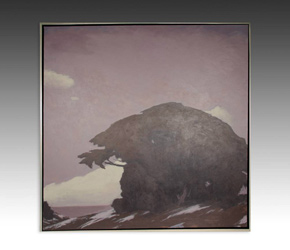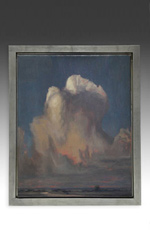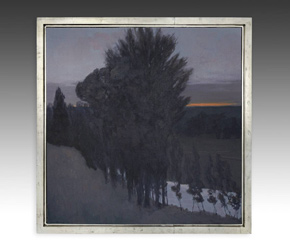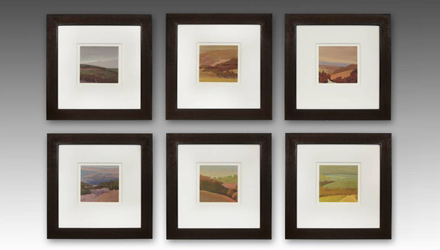Brian Sindler - Nocturnes
By Glen Joffe

|
|
|
|
Brian Sindler is an award-winning American artist whose works embody the essence of landscape painting. They have been called landscape renditions because they are not intended as exact renderings. Sindler grew up in a family immersed in art. Early on he studied music, eventually becoming a touring musician. However, the visual arts kept calling. At the American Academy of Art and The School of Representational Art, a famous French-style atelier, Sindler studied traditional figure painting. Some of his work from this early period has a photo-realist quality. Sindler might have stayed with figure painting and drawing, except one day a fellow painter invited him to leave the atelier and paint under the sun. Mildly frustrated with his initial attempts at landscape painting, he decided to return to the model named Nature until he ‘got the hang of it.’ In an instant, ten years had passed and never once did he miss the static, literal nature of figure drawing.

|
|
|
|
It would be easy to simply label Sindler a landscape or plein air (open air) painter, but his works encompass a far greater depth and complexity to be relegated to a single style or method of creation. He has developed a unique visual language stretching across the borders of landscape painting, conceptual art, realism and even surrealism. The experience he conveys in each painting is built upon countless influences.
While color and light are focal points in Sindler’s artistic process; shapes, composition and design are integral to his working process. From initial sketches to finished pieces, he thinks in terms of shape when it comes to elements like trees, ground, water, sky, clouds, or architectural structures. When he first goes outside, Sindler may make as many as a hundred sketches, ultimately choosing only a handful to translate into paintings. There may be a thousand details in any given landscape, but not all of them are relevant to his work. Many are inevitably omitted as editing is critical to his vision. His sketches represent the schematic simplification of a location; and in the next step of his working process he selects and refines which sketch design to pursue. According to Sindler, finding the right “armature†for a painting is half the battle.

|
|
|
|
Are all colors viewed the same through every eye? Apparently not; as recent research suggests color perception is actually derived from experience. Since no two people have identical experiences, even identical twins, it’s fair to say non-color blind, sighted people may see the same colors differently. Yet, regardless of how we parse shades, it’s a certainty color and emotions are closely linked. Pablo Picasso once remarked, “Colors, like features, follow the changes of the emotions.†It’s another way of saying; a skilled artist can manipulate color to elicit an emotional response. Sindler is a master at using color for this purpose. Essential to his artistic process; color is a tool he intentionally wields to evoke moods rather than dutifully replicate views.
In fact, Sindler rarely duplicates the exact colors appearing in the scenes he depicts. Rather, he observes the effects of light upon natural color; his final choices reflecting the colors he perceives during different day parts. Those color choices are tempered by a limited palette, which he acknowledges came about from an intense desire to fully understand color when he was in art school. Sindler uses only four variations of the three primary colors – red, blue and yellow – counting two shades of red, one cool and one warm, among the colors he deploys. His dexterity in mixing those basic pigments is a tribute to his refined color sense. However, his adjustment of this palette’s values – the range they run from light to dark – is what fully allows him to create, temper and refine the mood and atmosphere of his paintings. His unique, masterful ability to adjust color value compels the viewer to perceive his work from the standpoint of feeling rather than logic; and ultimately, to fully share his experience of the outdoor world.
.jpg)
|
|
|
|
In terms of format, determining the size of his canvas for a given painting is one of the first things Sindler considers. A dichotomy exists in his choices. In many of his large scale paintings, his subjects are depicted up close and more intimate. You might say, the closer the shapes, the larger the canvas. In these works, the viewer is forced to consider their connection to the location, to consider the atmosphere and “feel the breeze†as they become part of the landscape. In his smaller format paintings, the opposite tends to be true. He is inclined to zoom out and portray wide vistas, rolling landscapes and views with more information. In a sense, bigger scenes equal smaller canvases. He discovered this tendency in a series of gouache paintings he did on an inspiring trip to Tuscany, Italy; an area the artist regularly visits.
.jpg)
|
|
|
|
Sindler’s most recent momentum centers on Nocturne paintings. If one cares to delve into art history, nocturne painting is a phrase coined by the artist James McNeill Whistler, the European-based American artist, who was active in the 19th century. A leading proponent of the philosophy “art for art’s sake,†Whistler adapted the term nocturne from the musical phrase. It came to describe paintings depicting scenes occurring in the night, twilight, a veil of light or the absence of direct light. As applied to Sindler’s works, it characterizes paintings depicting night scenes as well as those capturing the periphery of darkness; moments when light has receded and we are left with an atmosphere filled with mood, wonder and anticipation.
Regardless of how much light is absent in Sindler’s nocturnes, whatever remains becomes a critical element in these paintings. It’s as if he has fully opened the aperture to his vision; yet, how long it can remain open is at best arbitrary and inexact because these paintings capture fading, fleeting moments. Sindler’s gift to nocturne painting is his ability to stop time with his brush so we may permanently experience and inhabit moments that are ephemeral and transitory. In many of his works, the time of day is inexact. For example, consider the paintings “Amsterdam Evening†and “New York Dawn,†two previously exhibited, award-winning works. If the titles did not intimate the time of day, we would still be left dwelling in the moment just before daylight makes an entry or exit. In the painting “Forest Way†we are not privy to the time of day. In this and many of his nocturnes, whether the sun is coming or going is immaterial. In all of them, we have an eternity to pierce a veil and contemplate the moments they reveal.
Sindler’s nocturne paintings have been described as moody and evocative; gateways to memories we all hold and share. Whether memories appear sharp and clear or faint and fragile; they do not involve our senses when recounted. In other words, memories exist outside the physical world; although that is where they may be ignited. The common denominator linking all memories is they emerge as pictures in our mind’s eye; and although these pictures may appear in varying degrees of intensity, they are like bridges connecting us to other people, places, times and situations. This is evident in the painting “Steel Bridge.†The scene it depicts seems so familiar most viewers ask, “Have I seen it before?†Another question arises: “Where?†And still another: “When?†The same questions arise with Sindler’s award-winning house paintings. It does not matter if you passed through a middle class suburb in Somewhere, USA and felt an affinity to brick houses at night. Everyone can relate to an illuminated entrance or window; to the realization that something exists beyond the light, whether it comes from a single bulb hanging in a doorway or a pane of glass encased in a frame.

|
|
|
Sindler’s style is unique among landscape painters; and commensurate with his skill has won him multiple awards and international recognition. One unique aspect of his work is its capacity to both sedate and stir at the same time on a deep, visceral level. We are invited to meditatively examine his paintings; and at the same time prompted to ponder and explore the emotions they evoke. In short, his paintings are moving. They engage viewers; not by clubbing them over the head with fantastic imagery or outrageous colors; but instead, by emphatically speaking in a quiet visual language. Ultimately, his paintings portray a world he feels more than sees. They are not mere documentations of outdoor scenes; but interpretive renderings leaving genuine impressions. Finally, upon examination we are invited to interpret them in the exact spirit they were rendered.